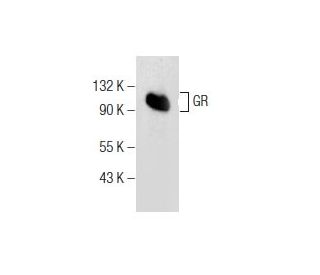


NIH/3T3 nuclear extract: sc-2138
- supplied in four vials, each containing 250 µg nuclear extract in 50 µl buffer
- provided in 20 mM HEPES (pH 7.9), 20% v/v glycerol, 0.1 M KCI, 0.2 mM EDTA, 0.5 mM PMSF and 0.5 mM DTT
- mouse nuclear extract; normal embryo fibroblast cells
- suitable for use in Gel Shift and Western Blotting assays
- Extracts should be stored at -70°C and repeated freezing and thawing should be avoided.
- prepared by the method of Dignam et al., (1983) Nucleic Acids Res. 11: 1475
QUICK LINKS
SEE ALSO...
The NIH/3T3 nuclear extract is derived from the NIH/3T3 cell line, an established line of embryonic mouse fibroblasts frequently employed in biological research, especially in the study of cell growth and oncogenesis. This nuclear extract is replete with various nuclear proteins, including transcription factors, polymerases, and regulatory proteins that are essential for gene regulation and cellular signaling studies. In the research context, NIH/3T3 nuclear extracts have been pivotal in elucidating the mechanisms of cell cycle regulation, cellular senescence, and transformation. They are particularly valuable for studying the role of transcription factors such as AP-1 and NF-κB in cellular response to growth factors and other external stimuli that influence cell growth and differentiation. Furthermore, these extracts have facilitated the investigation of signal transduction pathways that regulate gene expression in response to changes in the cellular environment, thus providing insights into the fundamental processes of cell communication and regulation. The use of NIH/3T3 nuclear extracts in these areas underscores their importance in basic cellular and molecular biology research.
NIH/3T3 nuclear extract References:
- Ecdysone-inducible expression of oncogenic Ha-Ras in NIH 3T3 cells leads to transient nuclear localization of activated extracellular signal-regulated kinase regulated by mitogen-activated protein kinase phosphatase-1. | Plows, D., et al. 2002. Biochem J. 362: 305-15. PMID: 11853538
- Transcription factors nuclear factor I and Sp1 interact with the murine collagen alpha 1 (I) promoter. | Nehls, MC., et al. 1991. Mol Cell Biol. 11: 4065-73. PMID: 2072909
- Statins modulate transcriptional activity of heme-oxygenase-1 promoter in NIH 3T3 Cells. | Mrad, MF., et al. 2012. J Cell Biochem. 113: 3466-75. PMID: 22689023
- Analysis of multiple forms of nuclear factor I in human and murine cell lines. | Goyal, N., et al. 1990. Mol Cell Biol. 10: 1041-8. PMID: 2304457
- Loss of responsiveness of an AP1-related factor, PEBP1, to 12-O-tetradecanoylphorbol-13-acetate after transformation of NIH 3T3 cells by the Ha-ras oncogene. | Satake, M., et al. 1989. J Virol. 63: 3669-77. PMID: 2547991
- A nuclear factor 1 binding site mediates the transcriptional activation of a type I collagen promoter by transforming growth factor-beta. | Rossi, P., et al. 1988. Cell. 52: 405-14. PMID: 2830985
- Role of an adenylyl cyclase isoform in ethanol′s effect on cAMP regulated gene expression in NIH 3T3 cells. | Hill, RA., et al. 2016. Biochem Biophys Rep. 8: 162-167. PMID: 28620651
- Separate binding sites for nuclear factor 1 and a CCAAT DNA binding factor in the mouse alpha 2(I) collagen promoter. | Oikarinen, J., et al. 1987. J Biol Chem. 262: 11064-70. PMID: 3038906
- Selective activation of transcription by a novel CCAAT binding factor. | Maity, SN., et al. 1988. Science. 241: 582-5. PMID: 3399893
- Conditional ectopic expression of C/EBP beta in NIH-3T3 cells induces PPAR gamma and stimulates adipogenesis. | Wu, Z., et al. 1995. Genes Dev. 9: 2350-63. PMID: 7557387
- Effects of acetaldehyde on nuclear protein binding to the nuclear factor I consensus sequence in the alpha 2(I) collagen promoter. | Anania, FA., et al. 1995. Hepatology. 21: 1640-8. PMID: 7768510
- A dominant negative protein kinase C zeta subspecies blocks NF-kappa B activation. | Diaz-Meco, MT., et al. 1993. Mol Cell Biol. 13: 4770-5. PMID: 8336714
- The leukemic core binding factor beta-smooth muscle myosin heavy chain (CBF beta-SMMHC) chimeric protein requires both CBF beta and myosin heavy chain domains for transformation of NIH 3T3 cells. | Adelstein, RS., et al. 1996. Proc Natl Acad Sci U S A. 93: 15523. PMID: 9340650
Ordering Information
| Product Name | Catalog # | UNIT | Price | Qty | FAVORITES | |
NIH/3T3 nuclear extract | sc-2138 | 250 µg/0.05 ml | $160.00 |
